My friend Mike and I went to Strategicon this weekend and played a bunch of games. Here are our notes. With a very few exceptions, we were both lucky to play with excellent Game Masters/Storytellers/Keepers/Dungeon Masters. In fact, we discussed how many of these games would be much harder to run for inexperienced GMs.
Mike and I are both fledgling game designers ourselves, so this weekend was a good exploration of various systems for us. I run a public RPG group here in Las Vegas, so I’m also always looking for games we can play in our Sunday games. Games that will be lightweight and easy to teach. Games that lend themselves to one-shot gaming sessions.
In any case, here’s our notes and thoughts on the various games and systems we played over the weekend:
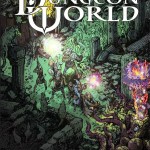 Dungeon World: Rules-light RPG. Very similar to Tunnels and Trolls. Roll 2d6 and add your modifiers for abilities and equipment (usually not more than +2). A 10+ is a complete success. 7-9 is a complicated success. 6 and below is a failure, but you get an experience point.
Dungeon World: Rules-light RPG. Very similar to Tunnels and Trolls. Roll 2d6 and add your modifiers for abilities and equipment (usually not more than +2). A 10+ is a complete success. 7-9 is a complicated success. 6 and below is a failure, but you get an experience point.
- Magic users are on par with “regular guys,” but we don’t know if you ever really get the big, world-shaking magic powers.
- Mike played a poison master. But at level 1, he had only 1 poison.
- Perception remained the most useful/used skill of the game. And being Wisdom-based, it was hard for us. A good question: Why is the cleric still the best at spotting traps? Carry-over from D&D.
- I played a barbarian, and really enjoyed the “complication die.” Basically, barbarians can increase one of their d6’s on a roll to a d8 (which is statistically like getting a +1). However, if the d8 is higher than the d6, something complicated or dangerous happens. I used this often, always got a higher d8, and loved the player-driven complication mechanic.
- Mike said it never felt epic.
- We both enjoyed the fact that failure (something we did a lot) meant XP.
- This game would still work in the hands of an inexperienced GM, but it could be challenging to come up with complications that move the story forward without turning a qualified success into a failure. One way to mitigate this would be for the players to narrate their own complications, with GM oversight
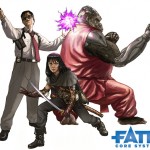 Fate Core: A rules-light game that uses special d6’s to determine success or failure. 2 sides are +’s, 2 are -‘s, and 2 are blank. Minuses subtract, plusses add, and you add your stat/skills to the die roll.
Fate Core: A rules-light game that uses special d6’s to determine success or failure. 2 sides are +’s, 2 are -‘s, and 2 are blank. Minuses subtract, plusses add, and you add your stat/skills to the die roll.
- We played the world and character creation part of the game first, then played a short narrative. This is how Fate is written to be played, but at conventions, you usually walk into the setting and characters already supplied by the GM. So it was awesome to step into a game that we created from the start. FYI: Our setting was “aliens invade ancient Mesopotamia,” and we decided that we are the aliens.
- I have this concern with Fate, which is that it’s hard to feel like you’re truly in danger.
- This may have been an issue with the GM/group, but I felt that it was hard as a player to contribute contributions to the story/plot. I know Fate is supposed to support that more with compels/invokes, but maybe because it’s rare to be low on fate points, I felt that we didn’t reach for those compels very often.
 Microscope: Also rules-light. I “GMed” this game (which doesn’t actually have a GM), so I won’t comment on whether or not there were GM problems/strengths. In Microscope, you create a setting and a timeline within that setting. Inside the timeline, you tell various stories through scenes.
Microscope: Also rules-light. I “GMed” this game (which doesn’t actually have a GM), so I won’t comment on whether or not there were GM problems/strengths. In Microscope, you create a setting and a timeline within that setting. Inside the timeline, you tell various stories through scenes.
- You get out what you put in. So it can be very rewarding, but you need involved players.
- There is no win/lose in this game.
- There are no mechanics for inter-party conflict (which is pretty much the entirety of every scene, since there is no GM playing the NPCs).
- One player being out of sync with the others can distort and change the tone of the story. At the same time, those distortions can make it a better story.
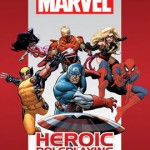 Marvel Pet Avengers: This was a “Pet Avengers” adventure in the Marvel Heroic RPG. Marvel RPG has a dice pool mechanic and some creative uses of initiative. It came out last year to much fanfare and hoopla, but this was the first time Mike or I had a chance to play it. Mike played a sneaky cat.
Marvel Pet Avengers: This was a “Pet Avengers” adventure in the Marvel Heroic RPG. Marvel RPG has a dice pool mechanic and some creative uses of initiative. It came out last year to much fanfare and hoopla, but this was the first time Mike or I had a chance to play it. Mike played a sneaky cat.
- Mike went from “I don’t know how to play this game,” (which is impressive, considering how much Mike plays RPGs and can understand them just from reading the book!) to “I want to run this game!”
- It’s more rules-intensive than Fate or even Dystopian Wars.
- It’s all crunch-with-options, though.
- It rewards creativity and player complications.
- A GM strength: the GM brought a bookmark prop to help visualize the dice pool. It was very useful for Mike and helped him understand the system perfectly.
- The Marvel universe is very familiar to players, even moreso with the recent Marvel franchise movies.
- The supporting characters are helpful, mathematically.
- The solo/buddy/team mechanic is something Mike is keenly interested in. Basically, your dice pool changes if you’re not in the configuration that your character is best built for (example: when Wolverine is in a team, he’s less effective than when he breaks away to do his own thing).
 Cat: Revised: A lightweight game in which you play a housecat, whose job in life is to protect the weak humans from unseen monsters.
Cat: Revised: A lightweight game in which you play a housecat, whose job in life is to protect the weak humans from unseen monsters.
- I loved this game. It was extremely fun, in part because of the GM and the players.
- It did not directly reward player-contributed complications.
- There’s a “nova” option in the game to spend a life and have as many attacks as you have magic dice (of course cats have magic– have you ever met a cat?!?)
- There’s not much failure in this game– it was hard to feel like we weren’t going to make it.
- Our particular game was narratively satisfying. The mouser in our party had promised to give a mouse to an NPC, a cat whose human was being destroyed by a boggin. At the end of the big-bad fight, the boggin had been shrunk down to the size of a rat. The NPC showed up just as our mouser pounced and was about to eat it (which would have burned him up from the inside!) and said “No. That’s my mouse!” Narratively beautiful (might have felt cheap if he hadn’t promised her a mouse, though).
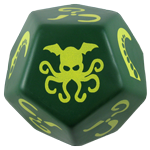 Cthulhu Dice LARP: It’s the Cthulhu Dice game, but you stand in a circle and throw the die at each other.
Cthulhu Dice LARP: It’s the Cthulhu Dice game, but you stand in a circle and throw the die at each other.
- Just because you are standing up does not mean you are playing a LARP.
- This would be more fun with some kind of hide-and-seek component.
- And characters. This would be more fun with characters.
- Okay, it was really a foam-die-enabled game of dodgeball. Without the dodging.
- I am not a fan of dodgeball.
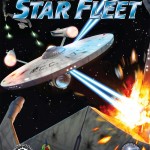 A Call to Arms: Star Fleet: Mike played the Kobayashi Maru scenario. It’s unwinnable for anyone except Kirk.
A Call to Arms: Star Fleet: Mike played the Kobayashi Maru scenario. It’s unwinnable for anyone except Kirk.
- There was one advantaged player. Oddly, that player then got all the dice luck, winning initiative every round and rolling lots of 6’s.
- There were 3 Klingon ships vs. the Enterprise. Each ship was controlled by one of the other players. Which meant there was no teamwork whatsoever.
- Mike was not allowed to run away. I guess Klingons aren’t allowed to make a “tactical re-definition of the axis of battle.”
- The Enterprise focused fire on Mike, taking him out first.
- Update: as it turns out, after Mike was eliminated, the Klingons rallied, the Enterprise player lost initiative 5 times in a row, and the Klingons prevailed. It may have been a good day to die, but it was an even better day for victory!
 D&D Next: The next edition of Dungeons & Dragons is in playtest phase right now. Mike played it at the con.
D&D Next: The next edition of Dungeons & Dragons is in playtest phase right now. Mike played it at the con.
- It’s more rules (than 4th edition), not less.
- The terrible game design of Vancian spells are back, but with at-wills, to make things more confusing.
- The demo pre-gens as written didn’t include spell descriptions, so players had to ask the GM what they could do.
- They played the hill giant adventure, at 9th level. Mike didn’t feel like a 9th level adventurer. Example: He was a 9th level thief who couldn’t climb a 20′ wall. Part of that was DM dickery– In town, Mike said “do you want to handwave that I buy some basic adventuring gear, or are you going to insist on a list?” When they got to the wall needing to be scaled, the DM claimed he didn’t have rope. Really?!?
- Mike’s impression was a lot of “you can’t do that” or “the rules don’t let that work.” Ugh. #1 complaint about 4e, with all the weaknesses of 3rd?
- Fewer utility options (like silence, etc.)
- There are no group skill challenges. So if 5 people in the party are stealthy, and 1 is not stealthy, the party gets spotted. At level 1, that’s acceptable. At level 9, it’s not.
- Plus: they played without magical equipment, so the focus was on the PCs and what they could do, rather than their stuff.
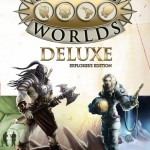 Savage Worlds: This is another lightweight system. Your stats start out at a d4 and you buy them up in die type (d6, d8, d10, etc) using character points during creation. Your skills start at a d4-2 and you can train them up with character points during creation (obviously, advancement also lets you train up skills and attributes). You take disadvantages and edges to flesh out your character. And everyone starts with some “bennies,” similar to fate points, which let you reroll. Target number is 4 to succeed, and if you roll the maximum on the die, you get to reroll and add the second die (an “exploding dice” mechanism). Player characters also get to roll a d6 as kind of a “wild die” whenever they need to roll, but it’s like a re-roll, not added to the initial die roll. You get more bennies when you tap into your disadvantages. We played in the Deadlands setting, which is the “weird west,” a blend of Wild Wild West and some supernatural.
Savage Worlds: This is another lightweight system. Your stats start out at a d4 and you buy them up in die type (d6, d8, d10, etc) using character points during creation. Your skills start at a d4-2 and you can train them up with character points during creation (obviously, advancement also lets you train up skills and attributes). You take disadvantages and edges to flesh out your character. And everyone starts with some “bennies,” similar to fate points, which let you reroll. Target number is 4 to succeed, and if you roll the maximum on the die, you get to reroll and add the second die (an “exploding dice” mechanism). Player characters also get to roll a d6 as kind of a “wild die” whenever they need to roll, but it’s like a re-roll, not added to the initial die roll. You get more bennies when you tap into your disadvantages. We played in the Deadlands setting, which is the “weird west,” a blend of Wild Wild West and some supernatural.
- A lot of what I want to say has to do with the DM’s strengths. He was well-prepped and well-propped. He had lots of props and artifacts– shot glasses for each player, Wanted posters for our character sheets, bullet casings for our bennie tokens, and an old-style wooden die for our wild die. Player piano music was going when I came in, and the table had green felt and poker cards laid out.
- I find Savage Worlds tends to be a bit “crit or fail,” but crits are common (it’s easy to roll a 6 on a d6). This session didn’t disprove that at all.
- The DM used maps and minis for tactical layout during combat, especially when we had gunfire, where range mattered. I appreciated this, since I want to try out some lightweight RPGs with minis– a dichotomy that isn’t easily reconciled.
- The DM didn’t take advantage of the supernatural in the setting, which disappointed me a bit– I took “doubting Thomas” for a disadvantage, so my character didn’t believe in the supernatural.
- Overall, this was an excellent game, though again, contributing player-driven complications was not easy.
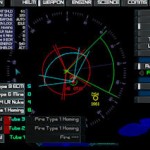 Artemis Bridge Simulator: Mike played this one. Players take the roles of a starship bridge crew. Each station has a subset of the total simulator (using laptops). For example, one player will be “engineering” and will only have control over the engines and speed. Another player will be piloting, and will only be able to steer. The whole team has to work together. The captain does not have a station, and instead directs all the other players.
Artemis Bridge Simulator: Mike played this one. Players take the roles of a starship bridge crew. Each station has a subset of the total simulator (using laptops). For example, one player will be “engineering” and will only have control over the engines and speed. Another player will be piloting, and will only be able to steer. The whole team has to work together. The captain does not have a station, and instead directs all the other players.
- This game demands cooperative play
- If you were in all-combat, all the time, it would be boring for the captain. The highlights of the captain’s role on a starship are when he diplomatically brings people to agreement.
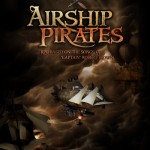 Abney Park Airship Pirates: It’s a steampunk RPG based on a band of musicians. Fairly standard steampunk stuff– you’re the crew of a pirate airship! Our characters were a broad mix… but we ran into the “star player syndrome” in which a charismatic player dominated the session, and the DM didn’t do enough to reign her in.
Abney Park Airship Pirates: It’s a steampunk RPG based on a band of musicians. Fairly standard steampunk stuff– you’re the crew of a pirate airship! Our characters were a broad mix… but we ran into the “star player syndrome” in which a charismatic player dominated the session, and the DM didn’t do enough to reign her in.
- There were few rewards for cooperative play.
- The math is counterintuitive– you roll a d6, and the 1s and 6s are successes, with the 6s exploding.
- It was unclear on our pre-gen character sheets what skill uses what stat, and we had to add them together. That’s more a GM failure, though– the skill list should have been already added together.
- I played the robotic (automaton) engineer, and found myself sitting on the very damaged ship for a lot of the adventure. That part was not so much fun, except it was in-character for me. However, it was hard for anyone (including the captain) to get any RP in edgewise against the Star Player.
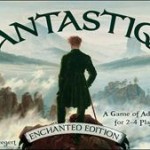 Fantastiqa: I brought this deck-building game with me, because I really wanted Mike to play it.
Fantastiqa: I brought this deck-building game with me, because I really wanted Mike to play it.
- Setup is a bit of a pain– you “stack the deck” of monsters so that the game is winnable early on.
- We played the simplified version of the game, which hasn’t become boring yet.
- Mike really liked it. After his first couple of turns, he had a sense of the game, though it was hard to remember how everything worked. I made mistakes, but fortunately they didn’t change the outcome of the game, just prolonged it.
Our impressions from the weekend. Mike’s favorite two games he played were Marvel Pet Avengers and Fantastiqa. Mine was Cat, and I couldn’t pick a 2nd, between Fate, Savage Worlds, and Dungeon World– all three were truly excellent systems and enjoyable games. For a long-term campaign, I would probably pick Savage Worlds as having enough “crunch” to keep a gaming group interested in the long-term. For a one-shot, Dungeon World was extremely fun.
Hi Stephanie, great to meet you at OrcCon!
On Dungeon World: “Why is the cleric still the best at spotting traps? Carry-over from D&D.”
I presume you’re talking about Discern Realities. The Thief has a better move than that specifically for detecting traps. Trap Expert (p.136), which is based on Dex, works much like Discern Realities, but the questions are specifically focused on traps, unlike Discern which has a very general set of questions.
So the Cleric is better than the Fighter (probably) at it, but the Thief is best.
“Mike said it never felt epic.”
That comes down to the GM. I’ve played in very gritty games where small groups of Goblins were a deadly proposition, but in the game I played on Saturday, we set off a volcano to destroy an giant Apocalypse Dragon that had laid waste to the entire land and in Living Dungeon World at OrcCon 2012, two groups of characters on seperate planes destroyed Orcus and his bone-exoskeleton-clad avatar: http://anarchangel23.livejournal.com/444061.html)
This game was also pretty epic: http://anarchangel23.livejournal.com/440876.html
On Artemis: That’s one that can depend a lot on the style of captain and how experienced they are at the various stations. I’ve never found combat boring as captain.
On FATE: I agree with you that by default it often doesn’t feel very perilous. But, that at least partially comes from my perceptiuon of the game as a continuation of Spirit of the Century and isn’t entirely fair. If you’re playing in a very pulpy mode (the default, to my mind), then it’s all gung-ho swashbuckling, but I have had characters die or come close on several occasions — once you take a few consequences and have a few stress boxes filled, it gets more tense!
Finally: We’ll have to get you guys up to Barcon at the next Strategicon. Are you on Twitter?
Yes, I’m on twitter as @mortaine! Glad you found the blog, Hamish!
I actually felt more epic (we were 1st level, after all) in Dungeon World than Mike did. I think that was more about our characters than the system, to be honest. We would both definitely play DW again– we enjoyed it. I’m currently thinking about my next campaign, and deciding among systems, DW, SW, and Fate are currently tied for my top pick. I’m working on a homebrew rule for Fate that would result in more consequences/stress and make it a little more perilous.
It’s possible that Mike’s pregen Thief didn’t have Trap Expert, or maybe Mike missed it when he read through it. I don’t really know– certainly, traps and ambushes seem like thiefly things to be able to Discern.
It seems to me that the easiest way to make Fate more perilous is by increasing NPC skills or weapon damages, or decreasing the flow of Fate Points. But if there’s some kind of spin on peril that those don’t provide, I’d be interested to hear about both the homebrew rule and the why you want it.
They certainly are things thieves should be good at, I agree! Every thief has Trap Expert, but depending on how well the GM knew the playbooks, Mike may have overlooked it and the GM (Sam?) not reminded him.
Hey, thanks for playing Fantastiqa, Stephanie! 🙂
I think decreasing the flow of Fate points would, indeed, make things more perilous, but at the cost of the “feel” of Fate. Another option is simply to keep the flow of Fate where it is, but require Fate points be spent more often, so the fate point economy stays low. You *want* players to feel like they need to dip into their negative aspects to gain their fate points.
I played with Otherkind Dice a while back and really liked it. For readers who might not be familiar, Whenever you have a challenge that calls for a dice roll, you name “what is the good outcome of this? What is one risk I take with this? What is another, more difficult risk I take?”
For example, I’m going to open a locked door. The good outcome is that I open it. Risk 1 is that someone knows I did it because they hear me or something. Risk 2 might be “but there’s a guy on the other side of the door and now he wants to hurt me.”
You then roll 3 dice. 1-2-3 is no, 4-5-6 is yes. You put one dice in each of your slots: the Good, Risk 1, Risk 2. So, if you rolled 4,3,3, you could have a complete success– the thing you wanted to happen did, and none of the risks happened.
I like this because it heightens the complications, plus it gives the player control over the complications you’re adding to the story.
I haven’t read Otherkind yet, but it’s the system that Psi*Run is based on, and I love that game.
I think your analysis of FATE is right on there.